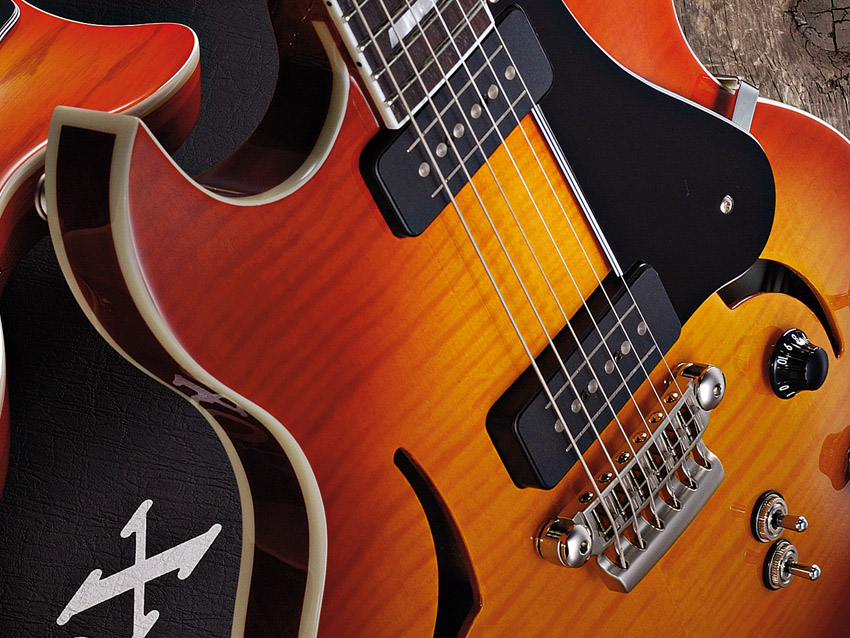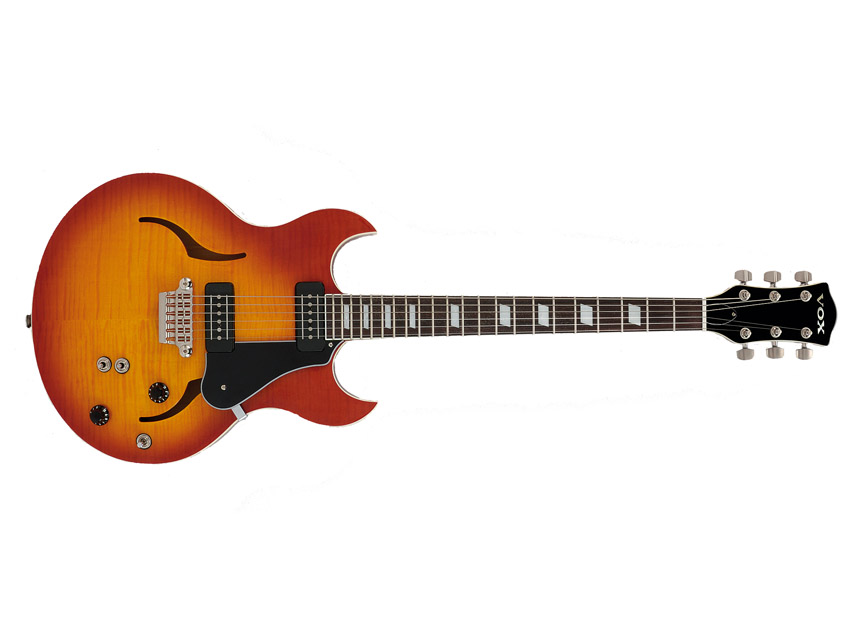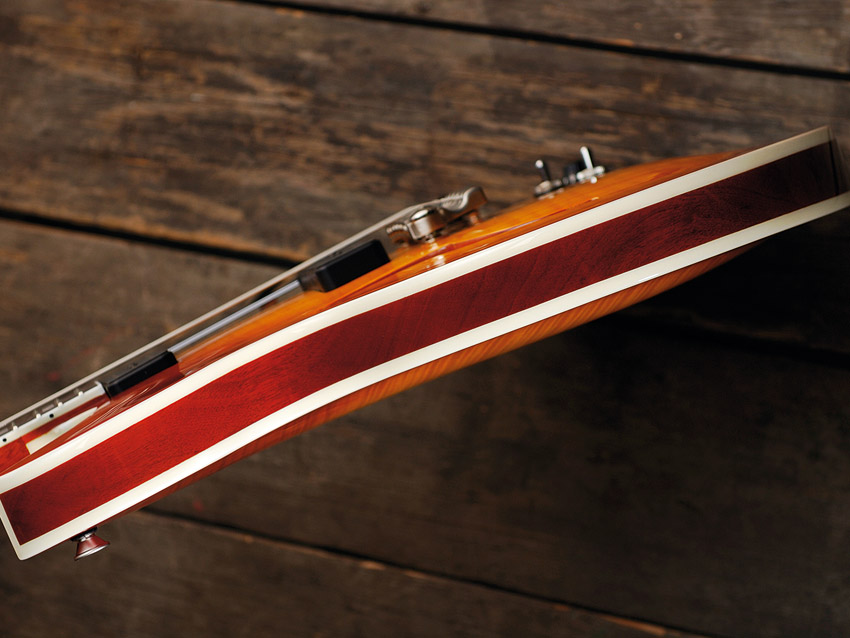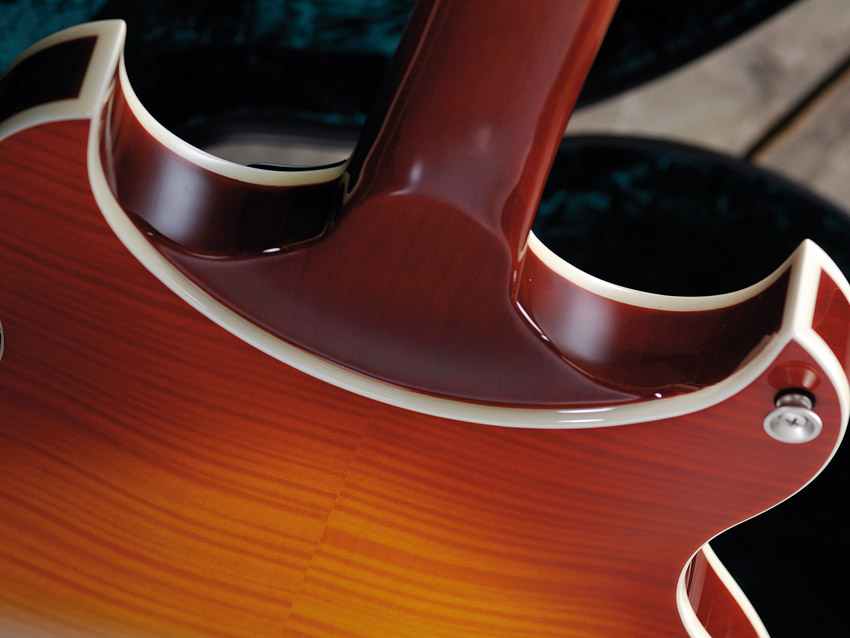MusicRadar Verdict
For sheer tone this is difficult to beat, even though we'd have preferred a little more definition between the modes. It has a lovely neck and the 3-D body contouring is a work of genius.
Pros
- +
Level of innovation. Great look. Body-hugging 3-D body contouring.
Cons
- -
The three mode tones aren't too distinct.
MusicRadar's got your back

Vox VH-HDC77

Vox VH-HDC77

Vox VH-HDC77

Vox VH-HDC77
The legacy of Vox-branded electric guitars goes all the way back to the early sixties, and arguably the most famous models of all can thank their legendary users for their notoriety.
The Stones' Brian Jones used the classic Teardrop Mark VI, while Joy Division singer Ian Curtis strummed a Phantom VI - two designs that were reissued in 1998.
"The 77 double-cutaway has plenty of low end, with a slightly less defined mid section and a sweet treble response."
These two models bear little resemblance to those of the past and instead include a selection of innovative features that should fascinate as well as impress. Although many of them are also included on the flagship Virage range, as well as the more modestly-priced Series 33 models, it's hoped that the models within the 77 and 55 series will mix the best modern guitar design with retail prices that won't cause anyone to turn away in disgust.
Currently the Series 77 includes just the double-cutaway design that we have on review here, but the Series 55 includes both double and single-cut designs.
Rich Lasner is vice president of development at Vox Guitars and during his time at Ibanez Hoshino was, among many other things, integral in the development of Steve Vai's JEM. Lasner's crack team also includes chief designer Eric Kirkland and senior production engineer Bob McDonald.
The 77 is a true semi-acoustic that, internally at least, sits between the designs of a Gibson ES-335 and a Gretsch 6120 in that it features neither a full-length central block nor a perfectly hollow body.
The top and back are fashioned from two separate three-layer laminates of maple, with a nicely flamed grade of maple on the outer facing. Then we have a solid mahogany centre: the outer sides and what Vox calls Tone Bars, which run from the heel, underneath the pickups, to the bridge posts.
"The HDC-77 is a combination of traditional laminated semi-hollow construction and our 3-D body contouring," explains Kirkland. "The top and back are pressed into shape on steel plates, which are then glued to the guitar's centre rim section that's cut out of solid wood."
What's more, the 77 features an extreme amount of body shaping and sculpting. Not only are the top and rear arched, but the body as a whole drops away from the straight plane of the fingerboard and strings and, in effect, curves around your own body as you play it.
It's called 3-D Body Contouring, and for good reason - the 77 provides a particularly intimate playing experience, as we've found with all these new Vox guitars. This contouring really comes into its own when played standing, as the act of pressing the guitar body into your own torso with your forearm puts the mahogany neck exactly where it needs to be.
The heel, which is also part of the internal mahogany rim of the guitar, is designed with both player comfort and tone in mind - it's possible to access all 22 frets without the thumb of your fretting hand coming into contact with the body at all.
"The advantage of our neck joint is that the body extends beyond where it would typically go and forms the heel of the neck, which lets us maximize the surface area of the joint to better transfer string energy," says Kirkland. "We like to think it looks cool as well!"
All modern Vox electrics feature the company's own design CoAxe pickups. Neither a single-coil nor humbucker in the traditional sense, the design incorporates a central row of pole-pieces encased in a high-impedance coil that's flanked by two blades. The entire construction is then surrounded by a low-impedance winding, which cancels the hum.
"The basic idea is that the coils are coaxial: they're on the same plane, not stacked," Kirkland tells us. "The advantage is that the centre sensing coil can work like a true single-coil and the outer, noise-cancelling coil is outside the magnetic field, between the central poles and the blades.
"Being outside the field allows the noise-cancelling coil to have relatively low impedance, so it doesn't take any of the sparkle away in the clean or crunch modes. Both the centre sensing coil and the outer noise-cancelling coil are tapped, so we can offer a good range of noise-free tone."
The modes Kirkland mentions refer to the three options that are available for each pickup: clean, crunch and dirty. These can also be described as single-coil, P-90 and humbucker.
The guitar's electrics therefore comprise a standard three-way toggle for pickup selection, plus two additional three-way switches that allow for the independent selection of the three modes for each pickup.
Even the bridge is a new design, intended to increase the intimacy of the join between metal and wood. It's an all-in-one system that sees an aluminium bridge and tailpiece fixed to the body via a pair of steel posts that can be easily raised or lowered with a simple hex wrench.
"The MaxConnect bridge enhances tone by improving the mechanical coupling of the bridge and the bridge posts," reckons Kirkland. "Typically, a bridge mounted to these kind of posts uses small screws to adjust its position on the posts for intonation. We extended the saddle adjustment range to make these screws unnecessary, so that the string tension pulls the bridge tight against the posts.
"The base is made of cast aluminium and, once we hit on the basic idea of in essence 'unfolding' a wraparound bridge, the design evolved easily."
Sounds
We should state at the outset that such is the efficiency of the guitar's semi-acoustic nature, it can sometimes be difficult to perceive the changes in tone when selecting different modes.
With a reasonably hot rock tone from the Orange TH30, the bridge pickup's humbucker tone is huge, with a real Billy Gibbons-style level of articulation. Using the same settings with the neck humbucker, the musical sustain is almost limitless and provides enough upper middle to avoid mushing up.
Cleaning the neck's HB mode up on the amp gives a more than usable tone for jazz as long as you round proceedings off further with the guitar's tone control, and the P-90 mode, with a push of amp drive, is lovely for lilting blues and half-chords.
The single-coil mode further reduces the mids, although without giving much in the way of a suitably Fendery twang, and combinations of the bridge pickup in that mode with the P-90 of the neck give full chords an unusual yet ear-catching character.
The 77 double cutaway has plenty of lower end, with a slightly less defined midsection and a sweet treble response. In any number of applications - from perfectly clean to all-out rock - it's very musically rounded, not brash.
We've not yet seen the flagship Virage II guitars, but Kirkland reckons, "the 77 is a bit more aggressive in looks and sound - and price! We think it might appeal to a 'modern rock' sort of player."
And there's no doubt in our minds that the 77 does modern rock very well indeed. But we feel the guitar's tonal strengths lie with more subtle styles: there's warmth and versatility here if you need it.
The 77 will appeal to anyone after a genuinely unique twist on the thinline semi theme.
Now listen to our audio demo to hear how VH-HDC77 sounds:
Intro
Sounds
Full demo
Simon Bradley is a guitar and especially rock guitar expert who worked for Guitarist magazine and has in the past contributed to world-leading music and guitar titles like MusicRadar (obviously), Guitarist, Guitar World and Louder. What he doesn't know about Brian May's playing and, especially, the Red Special, isn't worth knowing.
With its latest free update, Ableton has finally turned Note into the app I always wanted it to be
Technically capable, but struggle to make your tunes sound musical? 5 simple music theory hacks to make your tracks stand out
"Despite its size, it delivers impressive audio quality and premium functions as well as featuring a good selection of inspired sounds": Roland GO:Piano 88PX review









